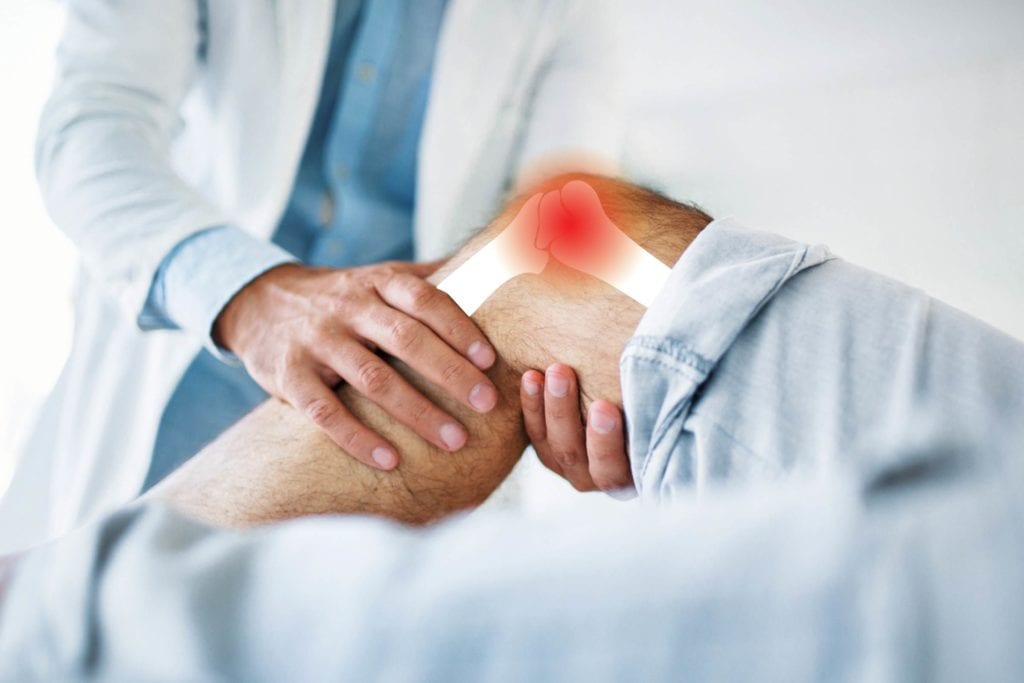

If you have persistent knee joint pain, arthritis in your knees could be the culprit. While many forms of arthritis exist, it’s usually fairly easy for your doctor to first determine which of the two main categories — osteoarthritis or inflammatory/autoimmune arthritis — you might have.
Those include what’s known as mechanical knee arthritis (osteoarthritis, or OA) or inflammatory/autoimmune knee arthritis, which includes a number of illnesses such as rheumatoid arthritis (RA), psoriatic arthritis, and ankylosing spondylitis.
While OA and inflammatory arthritis do share some symptoms — namely pain, tenderness, and swelling — the similarities tend to end there, as you’ll see below. The answers to the following questions can often help determine if your knee pain is osteoarthritis or inflammatory arthritis.
What Other Symptoms Are Linked with Knee Joint Pain?
Symptoms of osteoarthritis of the knee are generally limited to the joint itself, whereas inflammatory arthritis causes a wider array of issues. “Unlike OA, inflammatory arthritis is a systemic disease, which means it affects the whole body,” says CreakyJoints’ Medical Advisor Vinicius Domingues, MD, a rheumatologist in Daytona Beach, Florida.
In fact, it would be less common for someone with a form of inflammatory arthritis to experience pain in just one knee. That’s because symptoms are usually symmetrical (this means that both knees would be affected by inflammatory arthritis); what’s more, inflammatory arthritis symptoms usually don’t start in the knee.
For example, rheumatoid arthritis generally strikes the small joints in the fingers and toes first, while someone with ankylosing spondylitis is more likely to complain of low back and buttock pain, with knee arthritis pain developing later.
Depending on the type of inflammatory arthritis you have, you may experience other symptoms beyond knee joint pain. People with psoriatic arthritis exhibit the telltale scaly rash and plaques of psoriasis; eye inflammation can be a problem for those with psoriatic arthritis as well as ankylosing spondylitis, and people with rheumatoid arthritis may experience weight loss and fevers.
What Age Does Knee Arthritis Strike?
It’s possible to develop either category of knee arthritis at virtually any age. However, osteoarthritis of the knee most commonly occurs in people over age 40. That’s because it’s most often caused by the wear and tear that occurs in your knee joint as you age. As a result, the cartilage that cushions your knee begins to break down.
“When we do see knee osteoarthritis in younger people it’s usually because they experienced trauma to the knee that triggered cartilage loss,” says Dr. Domingues.
Certain types of inflammatory arthritis, in contrast, are more likely to develop earlier in life. Ankylosing spondylitis frequently develops between ages 20 and 40, while the age of onset of psoriatic arthritis is usually between 30 and 50.
What Does Arthritis in the Knee Feel Like?
If you battle morning stiffness in your knee for longer than an hour, it’s an indicator that you could have inflammatory arthritis instead of osteoarthritis in your knee.
“The pain of inflammatory arthritis is worse in the morning because it’s triggered by immobility,” Dr. Domingues says. “Motion alleviates the knee pain, so you’ll feel better as the day goes on.”
The opposite is true for people with OA in their knees: They can experience a brief period of morning stiffness, but their knee pain is at its worst later in the day because long periods of activity exacerbate OA symptoms.
Even the type of knee pain is different. “The pain of inflammatory arthritis comes from stiffness, whereas people with osteoarthritis describe sharp pains,” Domingues explains. “They say it’s almost like there’s a foreign body in their knee, which is the sensation of bone rubbing on bone.”
What Are Treatments for Knee Arthritis?
Though neither category of arthritis is curable, both kinds of knee arthritis can be managed well, particularly when caught early. That’s especially true for those with inflammatory arthritis.
“We know a lot more about inflammatory arthritis than we do about OA,” Dr. Domingues says. “And we have drugs that target the root cause of inflammatory arthritis — disease-modifying antirheumatic drugs, or DMARDs — which decrease inflammation, help preserve the joint, and ease pain.” Biologics, a more targeted type of DMARD, may be recommended for those who don’t get sufficient relief of knee pain and other symptoms from traditional DMARDs.
As for what to take for knee osteoarthritis, doctors often first recommend over-the-counter analgesics such as acetaminophen (Tylenol) and nonsteroidal anti-inflammatory drugs (Advil, Aleve, etc.), which are also sometimes used to alleviate the pain of inflammatory arthritis.
If those don’t help your knee OA, steroid injections may be a good next step for managing knee joint pain, or your doctor might suggest hyaluronan injections, which provide some of the cushioning lost by cartilage breakdown in your knee joint.
But because OA is a degenerative disease, which means it will likely get worse over time, these options mostly buy you time before you may ultimately need a knee replacement, which is the definitive treatment for moderate-to-severe knee OA, Dr. Domingues says.
Exercise and Other Knee Arthritis Remedies
For both OA and inflammatory knee arthritis patients, exercise is a key component of treatment, particularly if you’re overweight or obese (extra pounds put added pressure on your knees.)
Physical therapy may be a necessary first step for some to strengthen the muscles surrounding your knee joint and improve range of motion. Low-impact exercises — walking, cycling, or swimming — are usually best for those with arthritis of the knee, but you may be able to do higher-impact exercises if don’t have much joint damage.
To help make activity more comfortable, your doctor may recommend using assistive devices such as a cane or a knee brace or sleeve. Wearing well-cushioned, shock-absorbing shoes or inserts is also key; unsupportive styles such as flip-flops and flimsy flats only exacerbate knee joint pain. High heels, which throw off your alignment and place added stress on your knees, should also be avoided.
It’s also a good idea to talk to your doctor about how to get more rest, since many people with arthritis experience sleep disturbances that studies suggest can lead to pain, depression, and greater disability. Simply practicing good sleep hygiene — sticking to a regular bedtime, keeping your bedroom quiet and dark, exercising during the day, etc. — can help in many cases.
Keep Reading
Subscribe to CreakyJoints
Get the latest arthritis news in your inbox. Sign up for CreakyJoints and hear about the latest research updates and medical news that could affect you.





